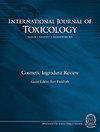Recovery Animals in Toxicology Studies: An Innovation and Quality Consortium Perspective on Best Practices With Case Study Examples
IF 1.2
4区 医学
Q4 PHARMACOLOGY & PHARMACY
引用次数: 0
Abstract
The inclusion of recovery animals in nonclinical safety studies that support clinical trials is undertaken with a wide diversity of approaches even while operating under harmonized regulatory guidance. While empirical evaluation of reversibility may enhance the overall nonclinical risk assessment, there are often overlooked opportunities to reduce recovery animal use by leveraging robust scientific and regulatory information. In the past, there were several attempts to benchmark recovery practices; however, recommendations have not been consistently applied across the pharmaceutical industry. A working group (WG) sponsored by the 3Rs Translational and Predictive Sciences Leadership Group of the IQ Consortium conducted a survey of current industry practice related to the evaluation of reversibility/recovery in repeat dose toxicity studies. Discussion among the WG representatives included member company strategies and case studies that highlight challenges and opportunities for continuous refinements in the use of recovery animals. The case studies presented in this paper demonstrate increasing alignment with the Society of Toxicologic Pathology recommendations (2013) towards (1) excluding recovery phase cohorts by default (include only when scientifically justified), (2) minimizing the number of recovery groups (e.g., control and one dose level), and (3) excluding controls in the recovery cohort by leveraging external and/or dosing phase data. Recovery group exclusion and decisions regarding the timing of reversibility evaluation may be driven by indication, modality, and/or other scientific or strategic factors using a weight of evidence approach. The results and recommendations discussed present opportunities to further decrease animal use without impacting the quality of human risk assessment.恢复毒理学研究中的动物:创新与质量联合会的最佳实践视角及案例研究实例
在支持临床试验的非临床安全性研究中使用恢复期动物的方法多种多样,即使是在统一的监管指导下也是如此。虽然对可逆性的经验评估可能会加强整体的非临床风险评估,但人们往往忽视了通过利用可靠的科学和监管信息来减少复原动物使用的机会。过去,人们曾多次尝试为恢复实践制定基准;但是,这些建议并没有在整个制药行业得到一致应用。由 IQ 联合会 3Rs 转化和预测科学领导小组赞助的一个工作组(WG)对当前行业中与重复剂量毒性研究中的可逆性/恢复性评估相关的实践进行了调查。工作组代表讨论的内容包括成员公司的策略和案例研究,这些策略和案例研究突出了在使用恢复期动物方面不断改进所面临的挑战和机遇。本文中介绍的案例研究表明,与毒理学病理学会的建议(2013 年)越来越一致,即:(1) 默认排除恢复期队列(仅在科学上合理时才纳入);(2) 尽量减少恢复组的数量(例如对照组和一个剂量水平);(3) 利用外部和/或剂量阶段数据排除恢复队列中的对照组。恢复组的排除和有关可逆性评估时机的决定可能受适应症、方式和/或其他科学或战略因素的驱动,采用证据权重法。所讨论的结果和建议为在不影响人类风险评估质量的情况下进一步减少动物使用提供了机会。
本文章由计算机程序翻译,如有差异,请以英文原文为准。
求助全文
约1分钟内获得全文
求助全文
来源期刊
CiteScore
3.40
自引率
4.50%
发文量
53
审稿时长
4.5 months
期刊介绍:
The International Journal of Toxicology publishes timely, peer-reviewed papers on current topics important to toxicologists. Six bi-monthly issues cover a wide range of topics, including contemporary issues in toxicology, safety assessments, novel approaches to toxicological testing, mechanisms of toxicity, biomarkers, and risk assessment. The Journal also publishes invited reviews on contemporary topics, and features articles based on symposia. In addition, supplemental issues are routinely published on various special topics, including three supplements devoted to contributions from the Cosmetic Review Expert Panel.

 求助内容:
求助内容: 应助结果提醒方式:
应助结果提醒方式:


